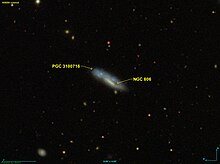| NGC 806 | |
|---|---|
 NGC 806 (SDSS) | |
| Observation data (J2000.0 epoch) | |
| Constellation | Cetus |
| Right ascension | 02h 03m 31.15s [1] |
| Declination | −09° 56′ 00.15″ [1] |
| Redshift | 0.013156 [1] |
| Heliocentric radial velocity | 3944 ± 9 km/s [1] |
| Distance | 166 Mly[2] |
| Apparent magnitude (V) | 14.10 [3] |
| Apparent magnitude (B) | 14.80 [3] |
| Characteristics | |
| Type | Scd pec? HII [1] |
| Apparent size (V) | 1.2 x 0.4 [1] |
| Other designations | |
| PGC 7835, MCG -2-6-21 | |
NGC 806 is a spiral galaxy approximately 166 million light-years away from Earth in the constellation Cetus.[1] It was discovered by American astronomer Lewis A. Swift on November 1, 1886 with the 16" refractor at Warner Observatory.[4]
Interaction with galaxy PGC 3100716[edit]

NGC 806 and PGC 3100716 form a pair of galaxies in gravitational interaction. These two galaxies are either colliding or are the result of a collision.[5]
PGC 3100716 is a spiral galaxy with an apparent size of 0.09 by 0.08 arcmin.[1] It was not included in the original version of the New General Catalogue, and was later added as NGC 806-2.[3]
See also[edit]
References[edit]
- ^ a b c d e f g h "NASA/IPAC Extragalactic Database". ned.ipac.caltech.edu. Retrieved November 29, 2017.
- ^ An object's distance from Earth can be determined using Hubble's law: v=Ho is Hubble's constant (70±5 (km/s)/Mpc). The relative uncertainty Δd/d divided by the distance is equal to the sum of the relative uncertainties of the velocity and v=Ho
- ^ a b c "Revised NGC Data for NGC 806". spider.seds.org. Retrieved December 9, 2017.
- ^ "Data for NGC 806". www.astronomy-mall.com. Retrieved December 9, 2017.
- ^ "Celestial Atlas". cseligman.com. Archived from the original on November 19, 2017. Retrieved December 2, 2017.
External links[edit]
- NGC 806 on WikiSky: DSS2, SDSS, GALEX, IRAS, Hydrogen α, X-Ray, Astrophoto, Sky Map, Articles and images
- SEDS
Well, that’s interesting to know that Psilotum nudum are known as whisk ferns. Psilotum nudum is the commoner species of the two. While the P. flaccidum is a rare species and is found in the tropical islands. Both the species are usually epiphytic in habit and grow upon tree ferns. These species may also be terrestrial and grow in humus or in the crevices of the rocks.
View the detailed Guide of Psilotum nudum: Detailed Study Of Psilotum Nudum (Whisk Fern), Classification, Anatomy, Reproduction